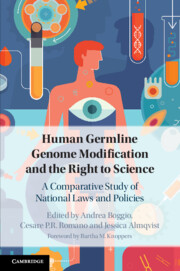 Human Germline Genome Modification and the Right to Science
Human Germline Genome Modification and the Right to Science Book contents
- Human Germline Genome Modification and the Right to Science
- Human Germline Genome Modification and the Right to Science
- Copyright page
- Dedication
- Contents
- Figures
- Tables
- Notes on Contributors
- Foreword
- Preface
- Acknowledgments
- Abbreviations
- 1 Introduction
- 2 The Governance of Human (Germline) Genome Modification at the International and Transnational Levels
- The Regulation of Genome Modification at the National Level
- Part I North America
- Part II Europe
- Part III Asia
- 16 The Regulation of Human Germline Genome Modification in Japan
- 17 The Regulation of Human Germline Genome Modification in the People’s Republic of China
- 18 The Regulation of Human Germline Genome Modification in the Republic of Korea
- 19 The Regulation of Human Germline Genome Modification in Singapore
- Part IV Other OECD Countries
- Part V Conclusions
- Index
19 - The Regulation of Human Germline Genome Modification in Singapore
from Part III - Asia
Published online by Cambridge University Press: 15 November 2019
- Human Germline Genome Modification and the Right to Science
- Human Germline Genome Modification and the Right to Science
- Copyright page
- Dedication
- Contents
- Figures
- Tables
- Notes on Contributors
- Foreword
- Preface
- Acknowledgments
- Abbreviations
- 1 Introduction
- 2 The Governance of Human (Germline) Genome Modification at the International and Transnational Levels
- The Regulation of Genome Modification at the National Level
- Part I North America
- Part II Europe
- Part III Asia
- 16 The Regulation of Human Germline Genome Modification in Japan
- 17 The Regulation of Human Germline Genome Modification in the People’s Republic of China
- 18 The Regulation of Human Germline Genome Modification in the Republic of Korea
- 19 The Regulation of Human Germline Genome Modification in Singapore
- Part IV Other OECD Countries
- Part V Conclusions
- Index
Summary
In Singapore, genome editing techniques may be applied in research but not for therapeutic (or clinical) purposes. Broadly speaking, the legal, regulatory and ethical provisions that apply to genome editing are drawn from five (at times overlapping) regulatory regimes: (i) research involving human embryos and stem cells; (ii) research involving assisted reproduction centers (and assisted reproduction services); (iii) research involving non-human animals; (iv) human biomedical research other than clinical trials; and (v) clinical trials. A human embryo may be created solely for the purposes of research (to study a genome editing technique, for instance), provided certain conditions are met and requisite approvals are obtained. Any such research should not extend beyond fourteen days from the time that the embryo was created. These requirements apply mutatis mutandis to the use of genome editing techniques to modify the genome of human oocytes and embryos. Owing to a moratorium that has been imposed, human germline genetic modification is not allowed in the clinical setting. However, it is less clear if such procedures could be applied in a clinical trial. This chapter provides an analysis of the regulatory framework and its application, as well as how it is expected to change in the foreseeable future.
Keywords
- Type
- Chapter
- Information
- Human Germline Genome Modification and the Right to ScienceA Comparative Study of National Laws and Policies, pp. 516 - 540Publisher: Cambridge University PressPrint publication year: 2020
- 1
- Cited by
